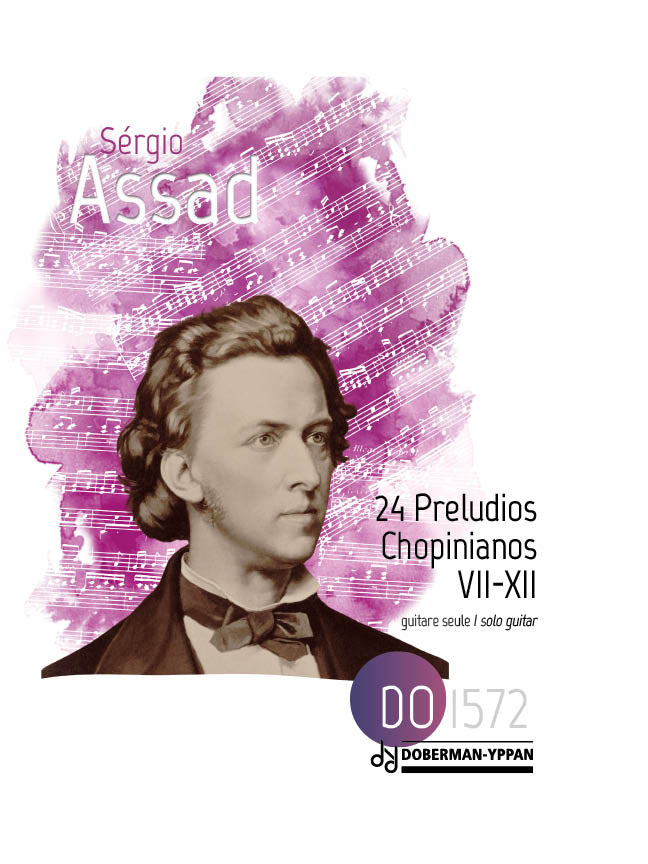Assad: 24 Preludios Chopinianos, Nos. 7-12
Expected to ship in 1-2 weeks.
- Composer: Sérgio Assad (1952-)
- Instrumentation: Guitar
- Work: 24 Preludios Chopinianos
- ISBN:
- Size: 8.9 x 12.0 inches
- Pages: 16
Description
The influence of Frédéric Chopin's music on Brazilian music dates back to the 19th century. Even during his time, Chopin's compositions began to shape the pianistic style of Ernesto Nazareth, often considered the father of Brazilian music. Moving into the 20th century, other composers also drew inspiration from Chopin's beautiful melodies. One notable example is Tom Jobim's song Insensatez (How Insensitive), which uses Chopin's Prelude No. 4, Op. 28 as its guiding framework. In fact, Prelude No. 4 was likely the first Chopin piece I ever heard as a child. Growing up, I became somewhat familiar with his music, particularly the preludes. These pieces have been—and continue to be—reinterpreted by pianists all over the world.
When the idea of creating a sort of «mirror» to Chopin's preludes occurred to me, I knew it would be a challenge. The guitar does not have the expansive harmonic and dynamic possibilities of the piano. Moreover, Chopin's 24 Preludes, Op. 28, were composed using all possible Major and Minor keys, following a pattern of alternating relative tonalities. in guitar composition, tonalities are often limited to those most resonant with open strings, as this enhances the instrument's natural sonority.
Faced with these challenges, I carefully studied Chopin's original scores. I understood from the beginning that my task was not to transcribe but rather to mirror the essence and flow of each prelude, focusing on the emotional and structural aspects of the music.
Each prelude required a different approach, guided by intuition. As a result, the pieces I created do not sound like mere copies but instead as works that draw from Chopin's preludes as distant models. I also aimed to respect the original tonalities and, from the outset, chose to maintain the guitar's standard tuning. Only toward the end of the cycle did I allow myself the liberty of retuning the guitar, using a sixth string tuned to F for one piece and to D for the final prelude.
The most challenging prelude to adapt was Prelude No. 16, originally in B-flat Minor, with its virtuosic, lightning-fast passages. for this piece, I resorted to creative techniques, including the use of a capo, to mirror the original key and retain its spirit.
This project was undertaken without pretension but with great care, dedication, and a deep admiration for one of the greatest composers in the history of music. Chopin's Preludes, Op. 28, remain a timeless masterpiece, and this work stands as a personal homage to his genius.
Publishers use a lot of words to describe what they sell, and we know it can be confusing. We've tried to be as clear as possible to make sure you get exactly what you are looking for. Below are descriptions of the terms that we use to describe the various formats that music often comes in.
Choral Score
A score for vocalists that only contains the vocal lines. The instrumental parts are not there for reference. Generally, cheaper than a vocal score and requires multiple copies for purchase.
Facsimile
Reproductions of the original hand-written scores from the composer.
Full Score
For ensemble music, this indicates that the edition contains all parts on a single system (there are not separate parts for each player). In larger ensembles, this is for the conductor.
Hardcover
Hardbound. Generally either linen-covered or half-leather.
Orchestral Parts
Similar to a wind set, this is a collection of parts. In the case of strings, the numbers listed are the number of copies included, though generally these are available individually (often with minimum quantities required).
Paperback
When publishers offer multiple bindings (e.g. hardcover) or study scores, this is the "standard" version. If you're planning to play the music, this is probably what you want.
Performance / Playing Score
A score of the music containing all parts on one system, intended for players to share. There are not separate parts for each player.
Set of Parts
For ensemble music, this indicates that there are separate individual parts for each player.
Solo Part with Piano Reduction
For solo pieces with orchestra, this is a version that contains a piano reduction of the orchestra parts. For piano pieces, two copies are typically needed for performance.
Study Score
A small (think choral size) copy of the complete score meant for studying, and not playing. They make great add-ons when learning concertos and small chamber works.
Vocal Score
A score prepared for vocalists that includes the piano/organ part or a reduction of the instrumental parts.
Wind Set
For orchestral music, this is a collection of wind and percussion parts. The specific quantities of each instrument are notated.
With Audio
In addition to the printed music, the edition contains recordings of the pieces. This may be an included CD, or access to files on the internet.
With / Without Fingering (Markings)
Some publishers prepare two copies - a pure Urtext edition that includes no fingering (or bowing) suggestions and a lightly edited version that includes a minimal number of editorial markings.


